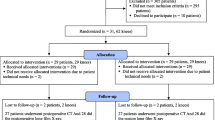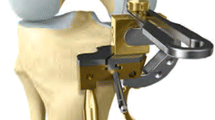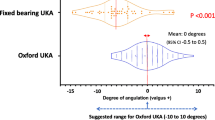Abstract
Background
It is becoming increasingly common to find patients candidate for total knee replacement with inaccessible femoral canal due to long femoral hip stems, osteo-synthetic hardware or diaphyseal mal-unions. To treat those patients avoiding complex and expensive procedures, we developed an innovative surgical technique based on a novel device called extra-medullary alignment system. We initially employed this technique in 18 cases with inaccessible femoral canal. Early results were so encouraging that we adopted this technique also for our standard cases.
Materials and methods
We report here our findings with a first series of 303 consecutive patients performed employing this technique. All patients received a cemented cruciate-retaining mobile-bearing total knee. Patients were followed for a minimum of 2 years and evaluated employing the Knee Society Score and the Oxford questionnaire. We also recorded the surgical time and any complication occurred intra-operatively and postoperatively. Patients’ X-rays were as well evaluated.
Results
No patient was lost to follow-up. Patients group average Knee Society and Oxford scores improved, respectively, from 45 and 16 pre-op to 92 and 45 at 2-year follow-up. Those results were compared and found aligned to those reported by similar historic control groups. Prosthetic implant alignment and surgical time demonstrated to be similar the one obtained using endo-medullary-referenced instruments. In this series, we did not observe any meaningful complication.
Conclusions
The extra-medullary alignment system seems to be a simple and reliable technique enabling to perform total knee replacement in a truly minimal invasive manner avoiding femoral canal violation.
Level of evidence
IV.




Similar content being viewed by others
Abbreviations
- EMAS:
-
Extra-medullary alignment system
- IM:
-
Intramedullary
- ROM:
-
Range of motion
- KSS:
-
Knee Society Score
References
Qian T, Ping S, Gang Z, Hua-Zi X, Hai-Xiao L (2017) Extramedullary versus intramedullary femoral alignment technique in total knee arthroplasty: a meta-analysis of randomized controlled trials. J Orthop Surg Res 12:82
Baldini A, Adravanti P (2008) Less invasive TKA. extramedullary femoral reference without navigation. Clin Orthop Relat Res 466:2694–2700
Barrack RL, Ruh EL, Williams BM, Ford AD, Foreman K, Nunley RM (2012) Patient specific cutting blocks are currently of no proven value. J Bone Joint Surg Br 94((Suppl A)):95–99
EunPark S, Lee CT (2007) Comparison of robotic-assisted and conventional manual implantation of a primary total knee arthroplasty. J Arthroplasty 22(7):1054–1059
Bonutti PM, Dethmers D, Slif DU, Seyler TM, Mont MA (2008) Computer navigation-assisted versus minimally invasive TKA. benefits and drawbacks. Clin Orthop Relat Res 466:2756
Davison BL (2003) Refracture following plate removal in supracondylar-intercondylar femur fractures. Orthopedics 26(2):157–159
Kovara FM, Strasserb E, Jaindla M, Endlerc G, Oberleitnera G (2015) Complications following implant removal in patients with proximal femur fractures—an observational study over 16 years. Orthop Traumatol Surg Res 101(7):785–789
Castellarin G (2019) A novel surgical technique to perform total knee arthroplasty in patients with inaccessible femoral medullary canal. J Orthopaedics 19:102–105
Fillingham YA, Ramkumar DB, Jevsevar DS, Yates AJ, Shores P, Mullen K, Bini SA, Clarke HD, Schemitsch E, Johnson RL, Memtsoudis SG, Sayeed SA, Sah AP, Della Valle CJ (2018) The efficacy of tranexamic acid in total knee arthroplasty: a network meta-analysis. J Arthroplasty 33(10):3090–3098.e1
Kandel L, Vasili C, Kirsh G (2006) Extramedullary femoral alignment instrumentation reduces blood loss after uncemented total knee arthroplasty. J Knee Surg 19(4):256–258
Laskin RS (2005) Minimally invasive total knee arthroplasty. the results justify its use. Clin Orthop Relat Res 440:54–59
Aglietti P, Baldini A, Buzzi R, Lup D, De Luca L (2005) Comparison of mobile-bearing and fixed-bearing total knee arthroplasty. a prospective randomized study. J Arthroplasty 20(2):145–153
Huang H, Yuan SuJ, Wang G-J (2005) The early results of high-flex total knee arthroplasty. a minimum of 2 years of follow-up. J Arthroplasty 20(5):674–679
Scuderi GR, Hedden DR, Maltry JA, Traina SM, Sheinkop MB, Hartzband MA (2012) Early clinical results of a high-flexion, posterior-stabilized, mobile-bearing total knee arthroplasty. a US investigational device exemption trial. J Arthroplasty 27(3):421–429
Caillouette JT, Anzel SH (1990) Fat embolism syndrome following the intramedullary alignment guide in total knee arthroplasty. Clin Orthop Relat Res 251:198–199
Fahmy NR, Chandler HP, Danylchuk K, Matta EB, Sunder N, Siliski JM (1990) Blood-gas and circulatory changes during total knee replacement. role of the intramedullary alignment rod. J Bone Joint Surg Am 72(1):19–26
Yau WP, Ng TP, Chiu KY (2001) Unusual complication associated with femoral intramedullary alignment guide in total knee arthroplasty. J Arthroplasty 16(2):247–249
Acknowledgements
None
Funding
None
Author information
Authors and Affiliations
Contributions
GC designed the follow-up program and performed all the surgeries.
VC reviewed patients data and X-rays.
Corresponding author
Ethics declarations
Conflict of interest
The authors whose names are listed immediately below certify that they have NO affiliations with or involvement in any organization or entity with any financial interest (such as honoraria; educational grants; participation in speakers’ bureaus; membership, employment, consultancies, stock ownership, or other equity interest; and expert testimony or patent-licensing arrangements), or non-financial interest (such as personal or professional relationships, affiliations, knowledge or beliefs) in the subject matter or materials discussed in this manuscript.
Consent for publication
Every patient gave his/her written informed consent to have his/her clinical records later used for this prospective study.
Availability of data and Material
Not applicable.
Ethical approval
All procedures performed in this study involving human participants were in accordance with the ethical standard of the institutional and/or national research committee and with the 1964 Declaration of Helsinki and its later amendments or comparable ethical standards.
Additional information
Publisher's Note
Springer Nature remains neutral with regard to jurisdictional claims in published maps and institutional affiliations.
Rights and permissions
About this article
Cite this article
Castellarin, G., Cimino, V. A simple technique to perform total knee replacement without violating the femoral canal: early clinical results on a cohort of 303 patients. Eur J Orthop Surg Traumatol 30, 1377–1382 (2020). https://doi.org/10.1007/s00590-020-02711-5
Received:
Accepted:
Published:
Issue Date:
DOI: https://doi.org/10.1007/s00590-020-02711-5




